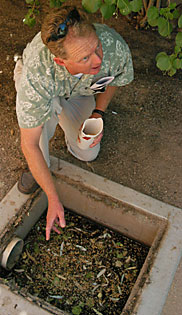 |
|
DEREKH FROUDE/Arizona Daily Wildcat
|
Assistant director of Facilities Management for Operations Services Tom Ellis sprinkles Vectobac, a mosquito larva killer, into a rainwater drain near the Math building yesterday in an attempt to halt the breeding of virus-carrying mosquitoes.
|
|
By Rachel Williamson
Arizona Daily Wildcat
September 17, 2002
Virus has not yet reached Arizona, but may be carried in by fall migration
The West Nile virus has infected more than 1,000 people from the East Coast to California this year, but Arizona residents have remained untouched to this point, as UA prepares to do battle against mosquitoes that propagate the virus.
"We're one of few states that it has not been reported in," said Frank Ramberg, assistant research scientist for the university's entomology department. "But with the start of bird migration season coming (in late fall and early winter), the cycle could get started here."
The virus, which arrived in the United States in 1999, is transmitted to humans through infected mosquitoes.
Most people who become infected with West Nile virus will have either no symptoms or only mild ones. However, on rare occasions, the West Nile virus infection can result in severe and sometimes fatal illnesses, including encephalitis, or inflammation of the brain.
The virus often goes unrecognized because it exhibits symptoms that can be similar to the flu.
It is spread by mosquitoes that get the disease from biting birds that carry the virus. The disease cannot be passed from person to person, but has spread quickly across the country because of bird migration patterns.
Only a small percentage of people who get the virus experience severe symptoms and die, Ramberg said.
Most susceptible are people older than 60or people with compromised immune systems, Ramberg said.
"You usually don't even know you've been hit by the virus," Ramberg said.
Since the virus has not been detected in Arizona yet, little information specific to the state is available about which types of mosquitoes carry the disease or which species of birds are more susceptible to it, said Henry Hagedorn, professor of entomology.
Eliminating breeding grounds for mosquitoes can help prevent the virus from spreading, Hagedorn said.
On campus, the roof drains on every UA building are potential mosquito-breeding areas.
But every 10 days, groundskeepers treat all pools of stagnant water in drains on campus with a "larvaecide" called Vectobac, said Tom Ellis, assistant director of operations services for facilities management.
Vectobac is not harmful to humans unlike insecticides, which can cause allergic reactions in people, Ellis said.
As for the adult mosquitoes that hang out in the grass and shrubs, not much can be done without using insecticides, Ellis said.
Mosquito problems on campus are no more of a threat than they are in the rest of Tucson, Ramberg said.

